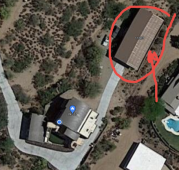nscottsdale
New Member
- Joined
- Aug 26, 2021
- Messages
- 77
I have an accessory building on my property 2k sqft workshop that has a sub panel with 90 amp breaker and 2-2-2-4 AL MHF going to my main panel at my house.
Arizona Power Service (APS) caps out the max system size you can have if you are going to grid tie. Based on my bills / usage (and a failed Tesla solar purchase) i know max for grid tie allowed by APS is 10.2 kW.
If i place solar panels on my accessory building , and get a 10kw grid tie inverter as part of a DIY permit/install, can I do it all at my accessory building panel - or for some reason must the inverter be on my house next to the meter and main panel? Teh solar will be on that accessory building roof.
Backstory on Tesla was that they don't have a panel fastener to go on my style of accessory building steel roof - they only do standing seam mounts.
Thanks in advance for any tips.

Arizona Power Service (APS) caps out the max system size you can have if you are going to grid tie. Based on my bills / usage (and a failed Tesla solar purchase) i know max for grid tie allowed by APS is 10.2 kW.
If i place solar panels on my accessory building , and get a 10kw grid tie inverter as part of a DIY permit/install, can I do it all at my accessory building panel - or for some reason must the inverter be on my house next to the meter and main panel? Teh solar will be on that accessory building roof.
Backstory on Tesla was that they don't have a panel fastener to go on my style of accessory building steel roof - they only do standing seam mounts.
Thanks in advance for any tips.



